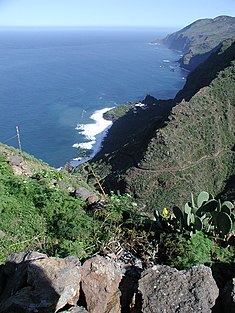Fajã
A fajã (Portuguese pronunciation: [fa'ʒɐ̃]) is a Portuguese-language term of obscure origin[1] designating supratidal talus-platform geology constructed from landslides or lava flows, that are relatively common coastal features, occurring on the toe of cliffs.[2] Although they exist throughout the world, they are distinct features of the islands of the Azores and Madeira, as well as of the Canary Islands, where the equivalent term in Spanish is fajana[3]. The term also designates a flat land of small extension, generally located by the sea and cultivable, formed of materials detached from the cliffs.[4][5]
Geology
Fajãs are created from collapsing cliffs or lava flows and are identifiable along the coast as "flat" surfaces (relative to the other geology).[6] Tides and tidal currents are minor influencers of the coastal morphology, and therefore, sedimentation and deposits became permanent.[2]
Composed of fertile soils, these microclimates allow the cultivation of a variety of staple and exotic plants, such as coffee.[6]
Azores
These debris fields exist in all the archipelago of the Azores, but are concentrated on the island of São Jorge .[6] The island is volcanic in character with steep cliffs running down to the coast, and where fajãs extend into the sea caused by the collapse of these cliffs. The long fetch of the Azores is a high-energy wave climate, and the steep submarine slopes and absence of shallow shelves produce localized patterns of wave shoaling, refraction and diffraction: especially during storms.[2] This leads to the fragmentation of the coast into a number of dynamic cells whose sediment alongshore is limited by impermeable boundaries.[2]
There are fajãs on both sides of the island: along the southern coast are the notable fajãs of Velas, Vimes, Bodes, Além, São João, Cardoso and Alabaçal, while in the north there are a succession of smaller fajãs (resulting from the collapse of lands cut by small ravines). The exception to this are the Fajãs of Caldeira do Santo Cristo (with an underwater cave and an open lagoon); the Fajã dos Cubres (with closed lagoon ecosystem) crystalline lake; the Fajã do Ouvidor, a dendritic fajã extending into the sea, used by fishers. Although many of these fajãs have been abandoned, the settlements which include abandoned homes, mills and fountains continue to be iconic outposts on hiking trails.
The fajãs are fertile and, historically, used in the cultivation of yams, maize and vegetables, although coffee, vineyards and tropical fruits were also grown. Here, several fajãs are scattered along the northern and southern coast, including the fajãs of Santo Cristo and Cubres, with their distinctive saltwater lagoons. One of the more original harvests happens at Fajã of Caldeira do Santo Cristo, where the lagoon supports cockles: this makes Santo Cristo a popular destination for the unique gastronomic cuisine in the Azores.
References
- Notes
- "fajã". Dicionário Priberam da Língua Portuguesa (in Portuguese). Retrieved 19 January 2020.
- G. Lameiras et al. (2009), p.827
- "Dictionary of the Royal Spanish Academy". Retrieved 1 July 2020.
- "fajã". Dicionário Priberam da Língua Portuguesa (in Portuguese). Retrieved 19 January 2020.
- "fajã". Infopédia (in Portuguese). Retrieved 19 January 2020.
- Deidda, Ségolène (9 October 2013). "The Azores, the thousand and one geological wonders' archipelago". NetGlobers/Europ Assistance. Archived from the original on 25 December 2013. Retrieved 23 March 2014.
- Sources
- Lameiras, G.; Fontiela, J.; Borges, P.; Calado, H.; Vieira, O.; Rangel, B.; Gallagher, A. (2009), "Coastal hazards of Fajã do Calhau (São Miguel - Azores): a first approach", Proceedings of the 10th International Coastal Symposium (PDF), Lisbon, Portugal: Journal of Coastal Research, pp. 827–831
